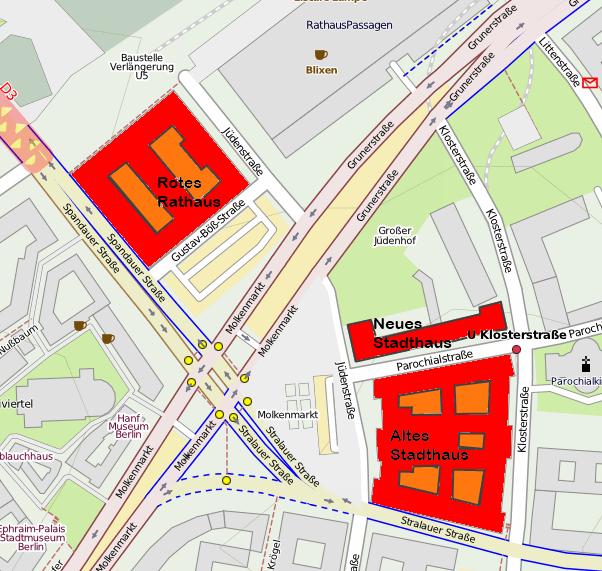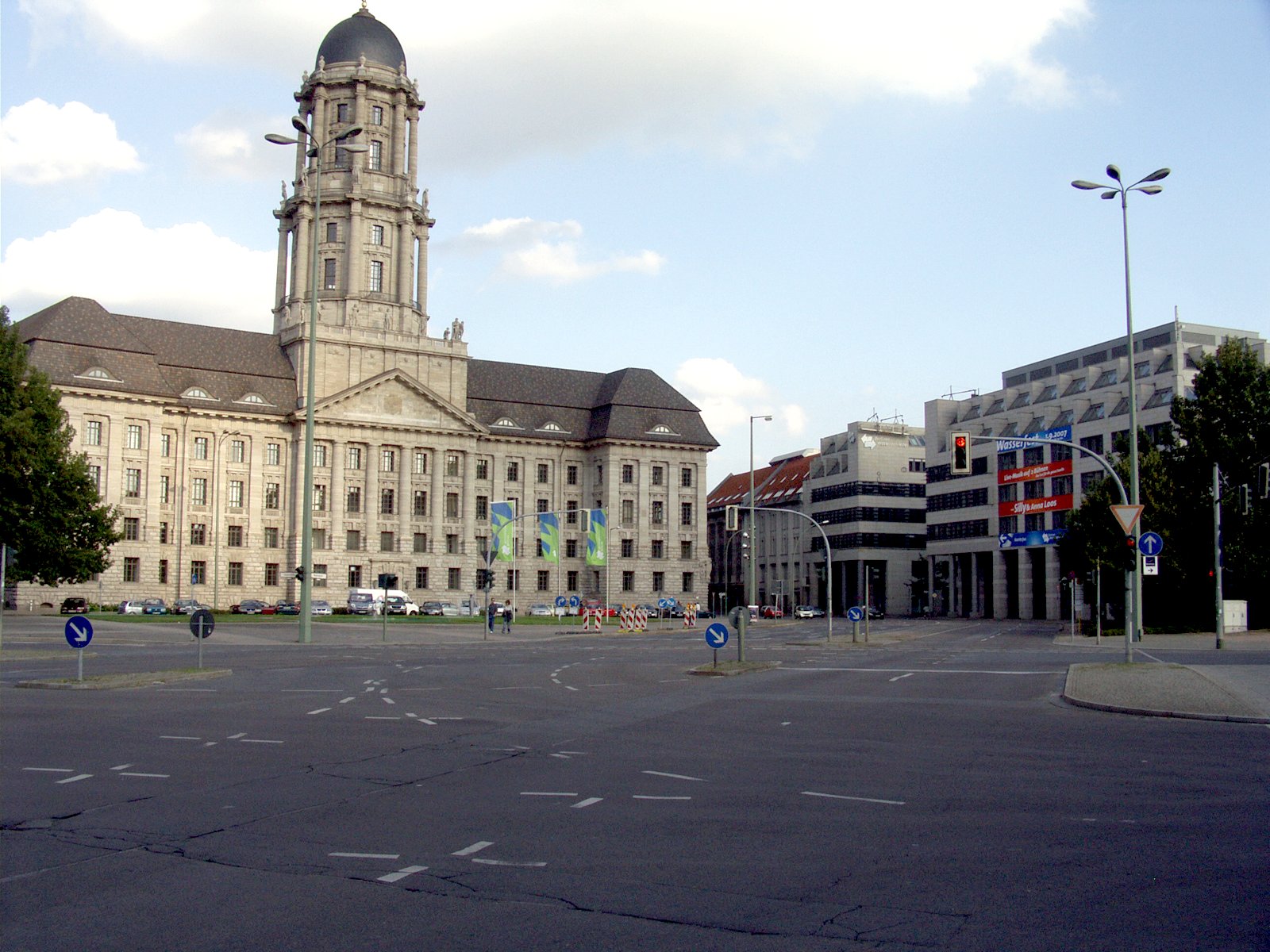|
Jüdenstraße
Jüdenstraße, or Juedenstrasse (see ß; ), is a street in central Berlin, the capital of Germany. It is in the borough of Mitte and runs between Rathausstraße and Stralauer Straße, next to the Rotes Rathaus, Berlin's town hall. It is one of the oldest streets in Berlin, dating from the late 13th century. Its name preserves the old East Central German expression for Jews, which was ''Jüden'', instead of New High German ''Juden''. The Yiddish term for Jews «יידן» (transliterated: Yidn) is based on the same German dialect form, with the German umlaut ''ü'' being represented by a «י» (here pronounced ). As the name of the street suggests, it once ran through the Jewish district of medieval Berlin, which was no ghetto-like obligatory residential area for Jews. An alley of Jüdenstraße named ''Großer Jüdenhof'' was the site of the synagogue, school and miqveh. They were founded on an estate of the Margrave of Brandenburg within his immunity district (''landesherr ... [...More Info...] [...Related Items...] OR: [Wikipedia] [Google] [Baidu] |
Altes Stadthaus, Berlin
Altes Stadthaus ("Old City Hall") is a former administrative building in Berlin, Germany, currently used by the Senate of Berlin, Senate. It faces the Molkenmarkt and is bound by four roads; Jüdenstraße (Berlin-Mitte), Jüdenstraße, Klosterstraße, Parochialstraße, and Stralauer Straße. Designed by Ludwig Hoffmann (architect), Ludwig Hoffmann, chief of construction for the city, it was built in 1902–11 at a cost of 7 million German gold mark, marks () to supplement the Rotes Rathaus. The building has five courtyards and features many sculptures, including 29 allegorical representations of civic virtues and of Greek deities which are mounted on the tower. A Georg Wrba sculpture of a bear, the symbol of Berlin, is located in the central ''Bärensaal'' (Bear Hall). Originally called the "Neues Stadthaus" (New City House), it became the seat of the Council of Ministers of the GDR after World War II. The building next to it became the center of administration for East Ber ... [...More Info...] [...Related Items...] OR: [Wikipedia] [Google] [Baidu] |
Molkenmarkt
Molkenmarkt (literally: "whey market") is the oldest square in Berlin. It is located in the Alt-Berlin quarter of the Mitte district, in the historic centre of the city. With approximately in size, it is today a major traffic junction, dominated by the large Altes Stadthaus administrative building on its southeastern side. History During the initial settlement around the Mühlendamm causeway across the Spree river about 1200 AD, the site developed as the central trading place. In the late 13th century, however, the venue became too small and a new marketplace beneath St. Mary's Church arose, which soon became more popular. The former site was thereafter known as ''Olde Markt'' or ''Alter Markt'' (Old Market) until 1685, when it was renamed to ''Mulkenmarkt'', later to change to ''Molkenmarkt'',Olde Markt Berlingeschichte.de, |
Horst Wessel
Horst Ludwig Georg Erich Wessel (9 October 1907 – 23 February 1930) was a member of the Sturmabteilung (SA), the paramilitary wing of the Nazi Party, who became a propaganda symbol in Nazi Germany following his murder in 1930 by two members of the Communist Party of Germany (KPD). After his death, Nazi Propaganda Minister Joseph Goebbels elevated him into a martyr for the Nazi Party. Wessel first joined a number of youth groups and extreme right-wing paramilitary groups, but later resigned from them and joined the SA, the original paramilitary wing of the Nazi Party. He rose to command several SA squads and districts. On 14 January 1930, he was shot in the head by two Communists. According to sources, his murder was due to a dispute related to his procuring (prostitution), procuring of women. Albrecht Höhler, Albrecht "Ali" Höhler was arrested and charged with his murder. Höhler was initially sentenced to six years in prison but was forcibly removed from jail and killed b ... [...More Info...] [...Related Items...] OR: [Wikipedia] [Google] [Baidu] |
Street
A street is a public thoroughfare in a city, town or village, typically lined with Building, buildings on one or both sides. Streets often include pavements (sidewalks), pedestrian crossings, and sometimes amenities like Street light, streetlights or Bench (furniture), benches. A street can be as simple as a level patch of Dirt road, dirt, but is more often pavement (material), paved with a hard, durable surface such as Tarmacadam, tarmac, concrete, cobblestone or brick. It can be designed for both social activity and movement. Originally, the word ''street'' simply meant a paved road (). The word ''street'' is still sometimes used informally as a synonym for ''road'', for example in connection with the ancient Watling Street, but city residents and urban planning, urban planners draw a significant modern distinction: a road's main function is transportation, while streets facilitate public interaction. [...More Info...] [...Related Items...] OR: [Wikipedia] [Google] [Baidu] |
Margrave Of Brandenburg
This article lists the Margraves and Electors of Brandenburg during the time when Brandenburg was a constituent state of the Holy Roman Empire. The Mark, or ''March'', of Brandenburg was one of the primary constituent states of the Holy Roman Empire. It was created in 1157 as the Margraviate of Brandenburg by Albert the Bear, Margrave of the Northern March. In 1356, by the terms of the Golden Bull of Charles IV, the Margrave of Brandenburg was given the permanent right to participate in the election of the Holy Roman Emperor with the title of Elector (). The early rulers came from several different dynasties, but from 1415 Brandenburg and its successor states were ruled by the House of Hohenzollern for over 500 years. From 1618 onward, Brandenburg was ruled in personal union with the Duchy of Prussia. The Hohenzollerns raised Prussia to a kingdom as the Kingdom of Prussia in 1701, and from then on Brandenburg was ''de facto'' treated as part of the kingdom even though it was le ... [...More Info...] [...Related Items...] OR: [Wikipedia] [Google] [Baidu] |
Streets In Berlin
Streets is the plural of street, a type of road. Streets or The Streets may also refer to: Music * Streets (band), a rock band fronted by Kansas vocalist Steve Walsh * ''Streets'' (punk album), a 1977 compilation album of various early UK punk bands * '' Streets...'', a 1975 album by Ralph McTell * '' Streets: A Rock Opera'', a 1991 album by Savatage * "Streets" (Doja Cat song), from the album ''Hot Pink'' (2019) * "Streets", a song by Avenged Sevenfold from the album ''Sounding the Seventh Trumpet'' (2001) * The Streets, alias of Mike Skinner, a British rapper * "The Streets" (song) by WC featuring Snoop Dogg and Nate Dogg, from the album ''Ghetto Heisman'' (2002) Other uses * ''Streets'' (film), a 1990 American horror film * Streets (ice cream), an Australian ice cream brand owned by Unilever * Streets (solitaire), a variant of the solitaire game Napoleon at St Helena * Tai Streets (born 1977), American football player * Will Streets John William Streets (24 March 1886 � ... [...More Info...] [...Related Items...] OR: [Wikipedia] [Google] [Baidu] |
Ethnic Enclaves In Germany
An ethnicity or ethnic group is a group of people with shared attributes, which they collectively believe to have, and long-term endogamy. Ethnicities share attributes like language, culture, common sets of ancestry, traditions, society, religion, history or social treatment. Ethnicities may also have a narrow or broad spectrum of genetic ancestry, with some groups having mixed genetic ancestry. ''Ethnicity'' is sometimes used interchangeably with ''nation'', particularly in cases of ethnic nationalism. It is also used interchangeably with '' race'' although not all ethnicities identify as racial groups. By way of assimilation, acculturation, amalgamation, language shift, intermarriage, adoption and religious conversion, individuals or groups may over time shift from one ethnic group to another. Ethnic groups may be divided into subgroups or tribes, which over time may become separate ethnic groups themselves due to endogamy or physical isolation from the parent group. Co ... [...More Info...] [...Related Items...] OR: [Wikipedia] [Google] [Baidu] |
Parochialkirche
The Parochialkirche (literally the Reformed parochial church) is a Reformed church in the Klosterviertel neighbourhood of the Mitte borough in Berlin. The church, now a listed building, was built between 1695 and 1703. It is the oldest church in Berlin built as a Protestant place of worship. The church is now used and owned by the congregation of St. Mary's and St. Peter's, the merger of the parishes in the historical city center concluded on 23 September 2005. The congregation forms part of the Evangelical Church Berlin-Brandenburg-Silesian Upper Lusatia, a Protestant regional church body comprising Lutheran, Reformed and united Protestant congregations. Name When the prince-electoral family of Brandenburg, the Berlin-based Hohenzollern, converted from Lutheranism to Calvinism (in German usually: Reformed Church; in English mostly: Presbyterian church) in 1613, all parish churches of Berlin, then under the patronage and advowson of the Lutheran city council, remained Lutheran. ... [...More Info...] [...Related Items...] OR: [Wikipedia] [Google] [Baidu] |
Nikolaiviertel
The (; 'Nicholas Quarter') is an old Quarter (urban subdivision), quarter of the German capital of Berlin, founded . Together with nearby Cölln, they jointly make up Alt-Berlin, the reconstructed historical heart of the city. Located in the Mitte (locality), Mitte locality (in the Mitte, homonymous district), it is five minutes away from Alexanderplatz and Berlin Palace. Geography Situated on the eastern shore of the river Spree (river), Spree, it is bounded by the streets ''Rathausstraße'', ''Spandauer Straße'' and ''Mühlendamm''. The Boroughs and neighborhoods of Berlin, neighborhood itself is named for the eponymous deconsecrated (St. Nicholas Church, Berlin, 'St. Nicholas Church') at its heart. This is Berlin's oldest church and was dedicated to Saint Nicholas. History The two settlements of Old Berlin as well as Cölln on the other side of the Spree originated along an old trade route, the ('Mills Dam'), a Ford (crossing), ford where the river could be easily crosse ... [...More Info...] [...Related Items...] OR: [Wikipedia] [Google] [Baidu] |
Electorate Of Brandenburg
Brandenburg, officially the State of Brandenburg, is a state in northeastern Germany. Brandenburg borders Poland and the states of Berlin, Mecklenburg-Vorpommern, Lower Saxony, Saxony-Anhalt, and Saxony. It is the fifth-largest German state by area and the tenth-most populous, with 2.5 million residents. Potsdam is the state capital and largest city. Other major towns are Cottbus, Brandenburg an der Havel and Frankfurt (Oder). Brandenburg surrounds the national capital and city-state of Berlin. Together they form the Berlin/Brandenburg Metropolitan Region, the third-largest metropolitan area in Germany. There was an unsuccessful attempt to unify both states in 1996, however the states still cooperate on many matters. Brandenburg originated in the Northern March in the 900s AD, from areas conquered from the Wends. It later became the Margraviate of Brandenburg, a major principality of the Holy Roman Empire. In the 15th century, it came under the rule of the House of H ... [...More Info...] [...Related Items...] OR: [Wikipedia] [Google] [Baidu] |
Joachim I Nestor, Elector Of Brandenburg
Joachim I Nestor (21 February 1484 – 11 July 1535) was a Prince-elector of the Margraviate of Brandenburg (1499–1535), the fifth member of the House of Hohenzollern. His nickname was taken from King Nestor of Greek mythology. Biography The eldest son of John Cicero, Elector of Brandenburg, Joachim received an excellent education under the supervision of Dietrich von Bülow, Bishop of Lebus and Chancellor of Frankfurt University. He became Elector of Brandenburg upon his father's death in January 1499, and soon afterwards married Elizabeth of Denmark, daughter of King John of Denmark in 1502. They had five children: # Joachim II Hector (9 January 1505 – 3 January 1571) # Anna (1507 – 19 June 1567) married Albert VII, Duke of Mecklenburg-Güstrow # Elisabeth (24 August 1510 – 25 May 1558) in 1525 married firstly Eric I of Brunswick-Kalenberg and in 1545 secondly Poppo XII, count of Henneberg # Margaret (29 September 1511 – 1577), married firstly on 23 ... [...More Info...] [...Related Items...] OR: [Wikipedia] [Google] [Baidu] |




